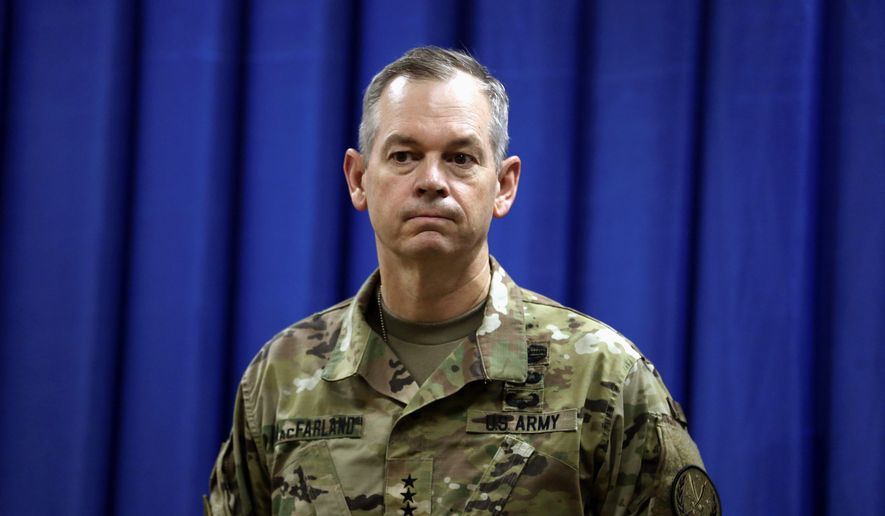The American-led war against the Islamic State has turned a corner over the last year, from a stalemated conflict to one where local and coalition forces in both Syria and Iraq are on the cusp of driving the insurgents from their Middle East strongholds, the departing U.S. commander leading the fight said Wednesday.
“Eleven months ago, there were questions about our strategy, the capacity and the will of our partners” to oust the Islamic State from its Iraqi and Syrian strongholds of Mosul and Raqqa, Lt. Gen. Sean MacFarland told reporters Wednesday during his last briefing as the head of U.S. operations in Iraq.
“Since then, all these questions have been answered, not by words, but by deeds and our approach is paying off,” the three-star general said.
Lt. Gen. Stephen Townsend, head of the 18th Airborne Corps, will take over for Gen. McFarland within weeks to oversee the long-awaited coalition assault on Mosul and Raqqa.
Rehabilitation work by American and Iraqi forces on the military air base in the Iraqi town of al Qayyara, about 40 miles south of Mosul, is nearly complete, according to Gen. MacFarland. The airfield, which is home to an estimated 400 U.S. military personnel, will act as the main logistics and air support hub for Iraqi forces pressing into Mosul’s southern flanks.
“We still have quite a bit of work to do in Qayyara Air Base,” Gen. MacFarland said. “We’re not quite there yet, but it’ll get here.”
In June, Defense Secretary Ashton Carter announced the deployment of 560 additional U.S. troops into Iraq, with a majority of those troops being based at the air base. The deployment bumped up the unofficial U.S. troop count in Iraq to roughly 6,000.
Pentagon officials have repeatedly stated the air base will strictly be used to ferry in weapons, supplies and equipment for advancing Iraqi and coalition forces once the siege of Mosul begins. However, defense analysts have speculated the base could also support U.S. and coalition attack aircraft providing air support to advancing forces.
The Mosul campaign could begin as soon as September, Iraqi and Kurdish officials told The Washington Times earlier this month.
Over 200 U.S. troops, backed by additional American air power and a shipment of heavy weapons, were ordered into Iraq earlier this year to support the Mosul offensive, which administration officials had hoped would be under Iraqi direction by the end of the year.
But as planning for the Mosul operation has become bogged down by sectarian infighting in Baghdad, Obama administration and coalition officials have increasingly backed off claims the Islamic State stronghold would fall by the end of the year.
For his part, Gen. MacFarland was reluctant to reassert recent claims by Iraqi Prime Minister Haider al-Abadi and Defense Minister Khaled al-Obeidi that the city would be under Baghdad’s control by the new year.
“We’ll try to hurry that along as fast as we possibly can, but putting an exact time on it, I’d rather not,” the three-star general said.
The U.S. commander’s take on the offensive against Islamic State in Syria was markedly more optimistic. Members of the Syrian Democratic Forces, a collection of U.S.-supported paramilitary units, are within weeks of completely severing Islamic State’s primary supply line into Raqqa, he said.
Local forces backed by American airstrikes now control a majority of northern Syria’s Manbij district. The area, 100 miles southeast of the Turkish border city of Gaziantep, has long been the main artery for fighters, weapons and equipment heading into Raqqa. Roughly 300 U.S. special operations troops are on the ground in Syria advising SDF and Kurdish militias during the ongoing Manbij operation and eventual assault on Raqqa.
“Most of the city is now in the hands of the Syrian Democratic Forces [and] the pocket of enemy resistance shrinks on a daily basis in Manbij,” Gen. McaFarland said. “It won’t be months — it will be weeks maybe, maybe less than that.”
The Defense Department estimates that Islamic State fighters have lost roughly 45 percent — or 9,600 square miles — of the Iraqi territory they seized as they steamrolled their way across the border with Syria in 2014. In Syria, the group has lost 20 percent of the territory it once held. Losses in Ramadi, Hit, Rutba and now Fallujah have shaken the Islamic State’s aura, causing it to hemorrhage fighters, funding and territory.
But as Islamic State digs in for the looming fights for Mosul and Raqqa, it is preparing to go underground and return to its terrorist roots, targeting civilians in spectacularly bloody attacks spanning from Europe through the Middle East.
“Military success in Iraq and Syria will not necessarily mean the end of Daesh,” Gen. McaFarland said, using the Arabic name for the group. “We can expect the enemy to adapt, to morph into a true insurgent force and terrorist organization capable of horrific attacks like those others we’ve seen around the world.”
• Carlo Muñoz can be reached at cmunoz@washingtontimes.com.




Please read our comment policy before commenting.